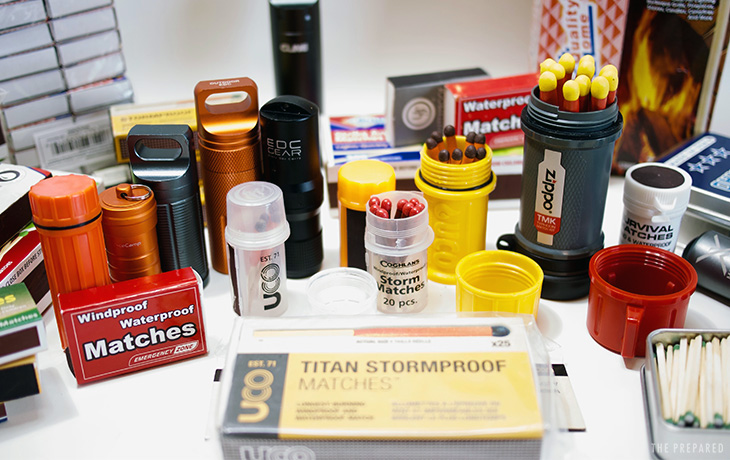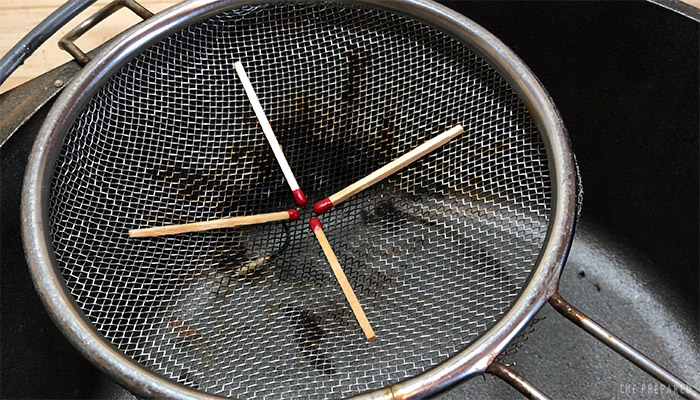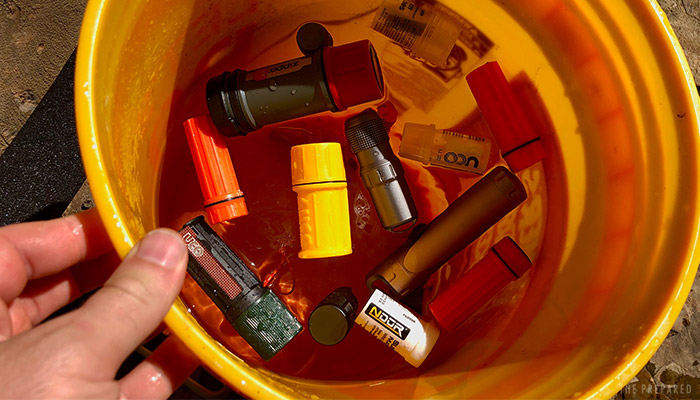Matches fall roughly in the middle of the survival fire kit stack. A good survival lighter is the primary choice for most people, while a ferro rod (i.e. fire steel) is a last resort or long-term backup. Together, all three options create the right emergency preparedness mix. Matches are great for prepping because:
- Matches are cheap, small, easy to store for a long time, lightweight, common, and relatively easy to use.
- Matches come with their own built-in tinder.
- High-quality storm matches can stay lit in the most extreme conditions, even when immersed in water. They’re essentially tiny flares.
- Matches can support other fire methods. For example, you can strike a ferro rod spark onto a match if you don’t have better tinder, or you can use the dying coals of a previous night’s fire to spark a match more easily than other tinders.
- Matches stored in a waterproof container will keep indefinitely.
But not all matches and containers are created equal — and many of their marketing claims like “waterproof” or “windproof” don’t work as advertised.
Tips:
- You should have matches stored in your home and emergency bags. They’re also fine for EDC, although most prefer a lighter.
- We like a mix of the high-quality, expensive stormproof matches and the cheaper bulk matches.
- The expensive matches are great for your go-bags, since you won’t be carrying much bulk and want the dependable champions.
- The bulk matches are great for your home shelf, and you won’t need to waste the expensive ones if you’re simply starting a cooktop while sheltering in your home during events like a power outage.
- Moisture is the number one enemy of matches, so waterproof matches will store longer than regular matches, and matches stored in water-tight containers will keep longer than those outside.
- You can make your own DIY stormproof matches, but the overall difference in cost/effort isn’t worth it for most people.
- Strike anywhere matches are nice, but not necessary, so they became the odd-man-out through our testing. They also have a small risk of unintended ignition in the box (from rubbing against each other), but that risk is decreasing as tech improves.
- Expensive containers or those from otherwise-quality brands had surprising failure rates. Price is not a clear sign of quality in this market. There are some cases where you’ll want to buy the right matches, then ditch and replace the included low-quality container.
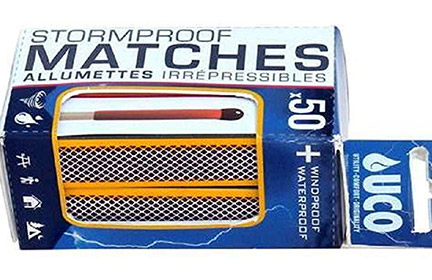
Best overall prep:
UCO Stormproof
The single best matches for preppers are the UCO Stormproof Matches at around $10 for a pack of 50. These large matches from the market leader in the survival and camping match space are expensive, but they crushed competitors and imitators in our testing. The UCO Stormproofs have a generous flame size and burn length, plus they can light in wind and pouring rain — which makes them better than even a lighter for getting a fire going in adverse conditions. We even immersed them in water while lit, and they stayed lit and flamed right back up after we pulled them out of the water. These are large matches, too large to fit in containers tailored for typical matches, but we think it’s worth it. We wish UCO was clearer in their product version naming, however.
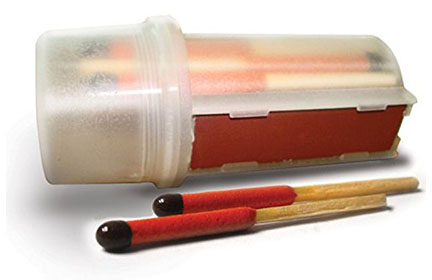
Same punch in smaller package:
UCO Survival Stormproof
If you want the Stormproof’s performance in a smaller package (that’s easier to get into other containers), the UCO Stormproof Survival Matches are the exact same match chemistry as their bigger brother in a smaller form. They performed well in our tests, with the obvious tradeoff of less burn time. There is just no reason to consider competitors in this size range, because even if you can save a little money on knock-offs they don’t work nearly as well.
Note: UCO’s product naming is confusing, as they seem to use the “Windproof and Waterproof” and “Stormproof” designations interchangeably. So you’ll sometimes see the former used, and sometimes the latter. This guide can help, but the main thing to pay attention to is the advertised burn time: a 15-second burn time means the “Stormproof” matches, and a 12-second burn time means the smaller “Survival Stormproof” matches.
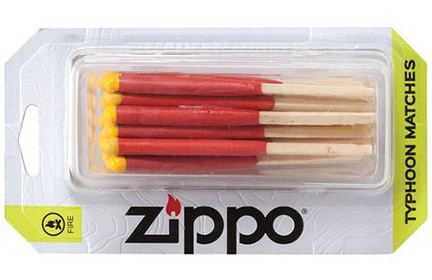
For your inner pyro
Zippo Typhoon
We were pleasantly surprised by the Zippo Typhoon Matches, which are cheaper yet very close in appearance and performance to their main competitor, the oversized UCO Titan Stormproof Matches. The Typhoons are extra large, giving you a little over 25 seconds on average of unstoppable, flare-like head burn to work with, followed by another 30 seconds of stick burn. The main downsides here are size and price, but if we could only carry one match bundle in an emergency and didn’t mind the per-unit price, it would be these bad boys.
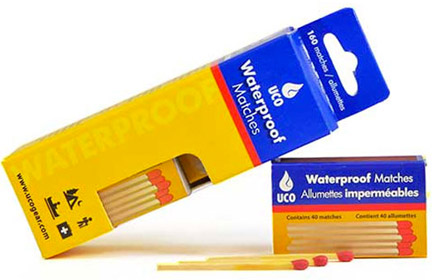
Buy in bulk:
UCO Waterproof
To stockpile cheaper “kitchen matches” in your home, we like the UCO Waterproof Matches. With the same low price, long burn time, and decent flame size as high-quality kitchen matches, these coated matches are an amazing value that will keep for longer in storage and will resist moisture in the field. These are inexpensive enough that we’d recommend buying and using them in daily life instead of kitchen matches, because then they serve dual use as preps.
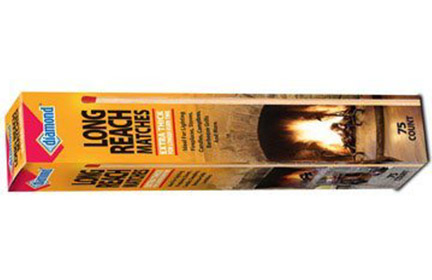
Best long matches:
Diamond Long Reach
If you like or need extra long matches — such as lighting an old fireplace or stove while sheltering at home — the Diamond Long Reach Matches are our top pick in this category. Large and consistent, with a decent flame and complete burn.
Some of the matches we reviewed came with special waterproof containers — or, they’re supposed to be waterproof, but our submersion testing showed that many are not, even from top brands like UCO.
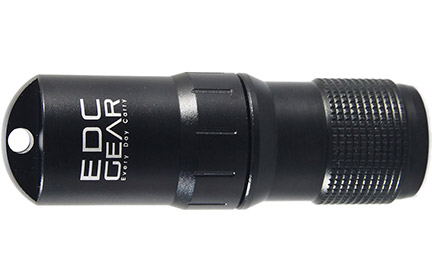
Best container:
Cevinee Waterproof EDC Keychain Capsule Tube
The best match container for preppers is the Cevinee Waterproof EDC Keychain Capsule Tube, which is big enough that we think they should drop the “keychain” label. This container has an internal striker pad that’s behind the watertight seal, and it’s the only such dedicated match container that passed both our submersion and crush tests. At only $9, it’s less than a third of the price of the Exotac Matchcap XL, but it’s a lot tougher and will serve you well in a survival situation. It also comes packed with a random collection of “EDC” items — matches, a sewing kit, Q-tips, etc. — but you should throw that stuff out and just pack it with UCO Stormproof.
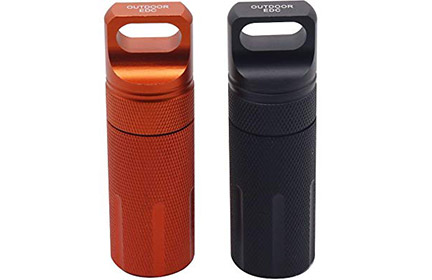
HRX Package Waterproof EDC Container
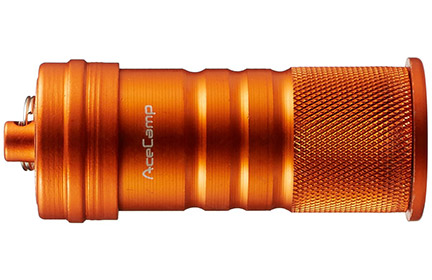
AceCamp Waterproof Matchbox Canister
Also great is the HRX Package Outdoor Waterproof EDC Survival Container Capsule. It lacks the integrated striker of the Cevinee, but it’s extremely tough and shrugged off being run over by a truck without a single dent, scratch, or small nick — you literally cannot tell it was run over by the front tire of a full-sized truck on close inspection. This is big enough for the UCO Stormproof matches, and is an absolutely bombproof container at a budget price.
The best small container for standard-sized matches is the AceCamp Waterproof Matchbox Canister. This is small and lightweight enough to be a true keychain EDC item, and it barely took any visible damage from our crush test. It’s very inexpensive yet super well made.
Match types and sizes
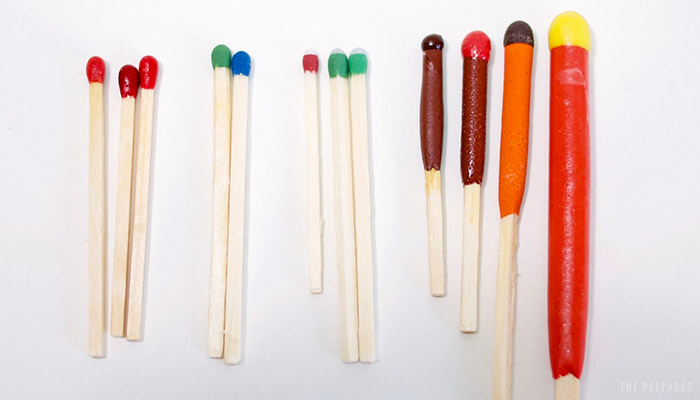
Strike anywhere
Strike anywhere (SA) matches combine all of the chemicals needed to light the match inside the match head itself. All you need to do is apply some friction. There are very few varieties of strike anywhere matches made right now because they weren’t considered safe — the matches could accidentally strike against each other in the box and start a fire. But recently these products have been reintroduced, and this review features three different brands of SA matches.
Safety matches (or “strike on box”)
Safety matches are so named because one of the chemicals needed to ignite the match (red phosphorous) has been removed from the match head and embedded in the gritty striker pad on the side of the box. So these matches will only light on a phosphorous-infused striker pad, making them safer than SA matches to store and transport. Almost all of the matches in this review are safety matches of some kind.
Waterproof matches
How to waterproof matches: Take safety matches and coat them with a hard, clear, lacquer-type coating (e.g. parafin wax) that keeps moisture out.
Many of these from different brands look very similar, but close inspection reveals differences in wood type and head material. All of the waterproof matches in this review would light when wet, although you only get a few seconds of burn from the head because once the flame reaches wet wood it goes out.
Stormproof matches
The most basic stormproof matches are essentially strike-on-box matches with extra-long heads. You can easily make these by grinding up match heads and wetting them into a paste that you then apply to wood and let dry.
Proper stormproof matches are more complicated. The minimum level is set by the NATO “lifeboat” matches. The UCO Stormproof and similar competitors are a step beyond that because they add lead tetroxide, which decomposes into lead and oxygen when heated, with the oxygen fueling the burn and contributing to these matches’ ability to work under water. They also have some red phosphorous mixed back in, though not enough to make them strike anywhere.
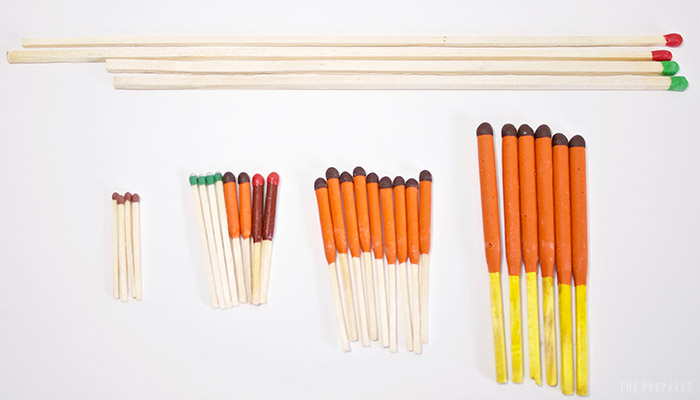
Penny matches
These small matches are well under two inches long and mostly marketed to smokers. They come in compact boxes that are easily pocketed and manipulated with one hand, which also can make them nice for EDC situations.
Kitchen matches
These are the standard-sized matches of about 2 inches in length from Diamond or Ohio Blue Tip that most people are familiar with. The kitchen match size is common for survival matches, as well, because many aftermarket match holders fit this size.
Survival matches
These are larger matches in the 2.5 to 4 inch range, and typically have stormproof-style head chemistries.
Long matches
These extra-long matches range from 9 to 12 inches, and are commonly used for fireplaces, grills, hot water heaters, and other applications where you need extra reach or burn time.
How we tested
Burn time: We chronographed the amount of time it took for each match to burn from initial strike to a flame that’s just barely visible. We initially waited for the match to go out entirely and start smoking, but some types of matches will continue to “burn” for a few seconds even though there’s no usable flame coming off them. All of the burn testing was done indoors, with no real wind or breeze circulating. (Yes, it got pretty smokey and our smoke detectors got a workout!)
We tested 12 of each kind of match in 3 groups of 4 matches each. We placed four matches on a wire mesh with the tips near each other and the bodies angled up at about 35 degrees, then held a lighter underneath to light the tips at the same time. We then averaged and rounded to the nearest second. We also rated the flame sizes, but this was pretty subjective. We used a Diamond Strike on Box as a baseline with a score of 5, and set the highest score at 10 for the biggest matches.
Strike surfaces: We tested the strike-anywhere matches on wet/dry sandpaper in grits from 100 to 2000, and on brick, different rock types, a Leatherman file, and even some rough plastic.
Container waterproofing: We submerged hand-tightened waterproof match containers in a bucket of water for 15 hours. We had six failures from that batch, and we re-tested those failures (after drying them out) for another 15 hours. One container passed the second test, indicating that the cap wasn’t tight enough during the first test, but the other five failed.
Container durability: We did a crush test on each container that passed the dunk test by first rolling it with the front driver’s side tire of a Nissan Titan XD, and then doing another submersion test on any that were still intact to check for hidden cracks.
Key test results
You can find more detailed testing notes on each individual product, below, but here are some general observations.
Many brands of matches were very inconsistent in terms of head size, body volume, flame size, and burn time. The cheaper Diamond matches were especially bad, but many of the smaller penny matches were inconsistent as well. Normally this inconsistency isn’t a problem because you’re not trying to conserve matches, so you just keep striking until you get one that works for you — but in an emergency this tends to matter.
All of the waterproof and stormproof matches we tested would light when wet, although only the head would burn if the match stick was soaked. None of the plain matches would light when wet.
We soaked some strike-on-box and strike-anywhere matches in water for an hour, and all the heads dissolved either partially or completely, confirming that moisture really is the enemy of match effectiveness and longevity.
One surprising result occurred when we tried to strike a storm match on our multi-tool file, and it worked. These matches are not strike-anywhere, but they do contain some red phosphorous in the head, and after a number of tries enough of that material got embedded into the grit of the file that it turned it into a striker. So this is a good backup option if your striker pad gets lost or damaged — you can still make the matches work on the fine grit side of a file.
We had mixed results with the container submersion testing, with some of the plastic match containers failing and all of the metal ones passing. We were surprised and disappointed at some of the containers that failed the submersion test, given that they seemed sturdy and had O-rings.
As for the container crush test, all of the plastic containers failed it, which wasn’t surprising. Some of the metal ones passed, while others deformed to varying degrees.
Interpreting the container test results
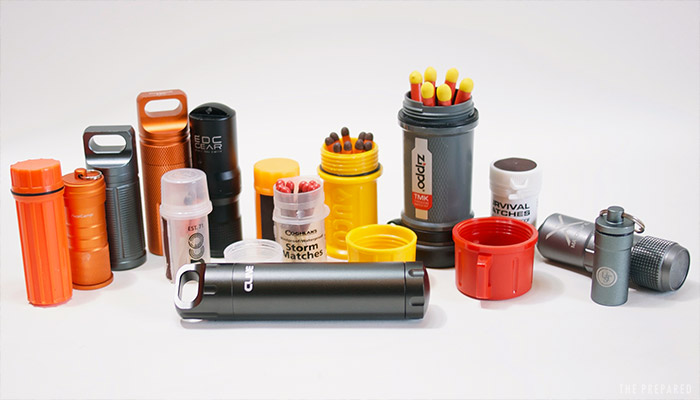
You may not think the container submersion test matters much — and if you live in an arid environment, it probably doesn’t — but moisture is the enemy of matches, so keeping them dry while stored is critical to ensuring that they work when you need them.
Strike anywhere matches are especially sensitive to moisture. One of the experts we consulted for this story has some strike anywhere matches that he’s stored unprotected in cardboard boxes for 14 years, and the white tips just crumble when touched — they’re totally worthless. The most likely culprit here is humidity of the Gulf Coast climate where he lives.
As for the crush test, this was pretty extreme, but it really did highlight the build quality of some of the metal containers. If you’re looking to save a few ounces, you’ll probably want to ignore the crush test results and use a quality plastic waterproof match container, such as the containers that come with either the UCO Titan Stormproof Match Kit or the UST Stormproof Match Kit. But if you can afford a very slight bump in weight, you can get a lot of extra durability for little extra money.
Full review notes of the top contenders
Matches
Coghlans Storm Matches: Only three out of four of these on average burn all the way up, the rest stop immediately after the head is used up. Very good flame and burn time (when they burn all the way), but you can do better for the price.
Coghlans Waterproof Matches: Not impressive, with a weak flame and very short burn time. Even the wooden stem on these doesn’t burn very well. Hard pass.
Coleman Waterproof Matches: These were weak and unimpressive. Not great uniformity of match head sizes or match bodies, and an anemic flame for a kitchen match size.
Diamond Green Light Strike Anywhere: These popular kitchen matches are pretty comparable in most respects to their Diamond safety match counterparts. And like the Diamond safety matches, they’re decent but not our top pick.
Diamond Long Reach Matches: By far the best of the two brands of extra long matches we tested. A generous amount of wood, consistently cut and sized, with uniform match heads and a large flame for the duration of the burn.
Diamond Strike On Box: Our baseline for safety matches, in terms of average flame and duration. We tested this popular brand first, and judged the others against it. Unfortunately, these were very inconsistent in terms of burn lengths and flame sizes, with some matches doing really well and others doing really poorly. Not a lot of uniformity in the bodies and heads, either. Overall, these are cheaply made bulk matches.
Emergency Zone Waterproof Matches: Good flame and decent burn times for the size, and also very cheap. Not the best value in this review, but not a bad pick if you spot them on sale.
Emergency Zone Windproof Waterproof Matches: Very poor performers in the “storm matches” category. Once the head is done burning, these matches are done — the wooden bodies just don’t keep going. Overpriced, too. Hard pass.
NDUR Survival Matches: When sold under the NDUR brand directly, these “NATO” matches are way overpriced for what you get. If you can get them for $0.16 a match or cheaper, there a good budget storm match. You’ll want a better container, though, since the “waterproof” one they ship in is chintzy and doesn’t hold up.
Ohio Blue Tip Safety Matches Light On Tin: The best bulk kitchen safety matches in the roundup, with good flames, very long burns, and consistency of manufacture. Twice as much per match as the Diamond safety matches, but superior and still quite cheap.
PBL Matches Strike Almost Anywhere in Tin: (Update 03/2022: These matches are no longer strike anywhere) These were the best strike anywhere matches we tested, mainly because they were sturdy and we didn’t have any heads snap off when lighting on concrete, sandpaper, or other materials. Good enough burn length and flame size, and a fair price.
ProForce NATO Lifeboat Matches: These are the NDUR matches, with the same case and branding, just marketed differently. You get a solid 12 seconds of head burn, then three out of four matches will continue to burn the wood for another 13 seconds. There is no reason to buy these over the slightly cheaper and much better UCO Survival Stormproof matches.
Quality Home Long Matches: Longer than the Diamond long matches, but not nearly as high-quality. Matches are inconsistent, and the flame is lower and they don’t burn as long.
Quality Home Penny Matches Strike on Box: These matches very consistently (and slowly) burn all the way up, hence the 30 second burn time listed. But the flame is quite small and will not stand up to much wind. When you combine the small flame size with the relatively high unit price, these are a pass.
Stansport Waterproof Matches: Rapid burn time, small flame. Just say no.
Stansport Waterproof/Windproof Matches: Superficially similar to the UCO Stormproof, but visual inspection reveals that they’re only colored to look like the UCO and aren’t the same head material. Only the head on these burns, not the body, so you get about 8 seconds max. They do light wet, but they aren’t submersible like the UCO Stormproof matches. Hard pass, especially since they’re more expensive than the superior matches they imitate.
Swedish Match, Three Stars Safety Matches: Similar to the Quality Home penny matches, but worse burn times.
UCO Long Burn Matches: Large enough to burn almost a minute, with really good flame. Not that expensive, especially for what you get. The main problem is the odd size, which makes them harder to find a waterproof container for that fits without wasting space.
UCO Stormproof Matches: Definitely the king of the stormproof match hill, and for good reason. Solid burn time, huge flame, lights wet, submersible in water without going out — they’re basically mini flares. Only drawbacks are the price and the odd size.
UCO Strike Anywhere: (Update 03/2022: This product has been discontinued) Decent performance, but not quite as good as the slightly more expensive PBL strike anywhere matches. We had a fair number of heads snap off with these, so they may be less sturdy. There’s no real reason to prefer these to the PBLs.
UCO Titan Stormproof Matches: These and the Zippo Typhoons are the biggest and baddest matches in this roundup. They’re just really large versions of the UCO Stormproof matches, with 25 seconds of head burn. The bodies don’t consistently burn all the way up, though.
UCO Waterproof Matches: The highest quality waterproof matches in this guide, with long burn times, good flame size, and a great price. Given that these are the same price as the Ohio Blue Tip with comparable performance and a waterproof coating added, these are the best deal in this guide for high-quality bulk matches to stock up on.
UCO Survival Stormproof matches: These are just the UCO Stormproof matches but in a regular kitchen match size (i.e. about 2 inches in length), so if you have a good container that holds kitchen matches and you want to upgrade to survival matches, these are great. Downside is the price. You get 12 seconds of head burn, and the wood burns pretty well.
UST Waterproof Matches: Very fast burning waterproof matches. Prefer the longer burning UCO, even though these have a slightly bigger flame.
Zippo Typhoon: Every bit as good as the UCO Titan Stormproof, with identical size and function, but about 20% cheaper.
Kits and containers
UCO Survival Stormproof Match Kit: This kit is not a bad deal, but the container failed our submersion test, twice. It could be worth considering if you can score it on sale, but there are better containers out there.
UCO Stormproof Match Kit: We were shocked that this container, which we all have in personal preps, utterly failed the submersion test. There was quite a bit of water in the container both times after the 15-hour soak, a huge disappointment.
UCO Titan Stormproof Match Kit: This is a high-quality, sturdy container that stayed dry in our submersion test. The strip on the side also endured the soaking well, and did not come off or disintegrate. Of course, it failed our crush test (all the plastic ones did), but it’s very lightweight so if you’re saving ounces and are using matches this big, it’s a winner.
UST Stormproof Matches with Waterproof Match Box: This container passed our submersion test, but not the crush test. The matches that come with this kit are poor knockoffs of UCO Stormproof matches, but are way more expensive. Avoid.
Zippo Typhoon Kit: We loved the design of this container, with the way the bottom striker pad is covered with a watertight cap. (Many of these containers have the fragile striker strip exposed on the outside.) But it spectacularly failed our submersion test.
Stansport Kit: The container is comparable to the UST Stormproof match container, but the striker pad on the top fell apart after the submersion test. The matches that it comes with aren’t great, either. There’s no reason to buy this when there are better options.
Coghlan’s Storm Matches Case: Didn’t pass the submersion test, and the matches are decent but not great.
Cevine Waterproof EDC Keychain Capsule Tube: A sturdy competitor to the Exotact Matchcap XL that pass all of our tests, including the crush test. It took a very slight deformation in our crush test, but a subsequent submersion test shows the seal still held. It has a similar design and features to the Exotac — including an internal striker — to the Exotac, but is tougher and less than 1/3 the price. Can hold the larger storm matches.
Exotac Matchcap XL: A great match container with a great design, but our only problem is that the bit of striker pad on the bottom of the unit comes off easily. That bottom pad definitely did not hold up in the submersion test. This is not a huge problem, since there’s an internal striker pad that stays dry. Overall very good, and perfectly sized for the UCO Stormproof Matches we recommend.
PPFISH containers: These containers are widely available on Amazon under a number of brands, and held up fine in our submersion test. They work for matches up to about 2.5 inches in length, but not the larger storm matches.
CLINE Outdoor Survival Waterproof Pill Bottle EDC: This container passed our submersion test (though not the crush test), and while it may work for pills it does not work for matches. Specifically, it has three design flaws that take it out of the running as a match holder. First each end unscrews, which means two O-rings and two potential points of failure. Second, both end caps are female and have an internal lip on them that large matches jam up against when you’re trying to close it. Finally, the rounded bottom makes tail standing impossible.
HRX Package Outdoor Waterproof EDC Survival Container Capsule: Another sturdy, inexpensive container that passed all our tests, and it’s large enough to hold the bigger survival matches.
AceCamp Waterproof Matchbox Canister: A very good machined aluminum match case that held up in our submersion and crush tests, and features a solid design and bright color for easy visual contrast in the wild.
UST Anodized Aluminum B.A.S.E. Case 0.5: High quality aluminum case that passed our submersion test, but failed the crush test by deforming just enough that it became impossible to open. Small enough for penny matches, but if you want to store kitchen matches you’ll need the next size up.
Coghlan’s Waterproof Match Case: These cases appear identical to the case that comes with the UST Stormproof matches, but aren’t quite the same on close inspection. This case did not pass the submersion test.
